
26 Jun 2025
Ash deals with the challenges of hospital treatment and social anxiety
“The whole experience has absolutely destroyed me but, strangely, it built Ash up.”
The prospect of weeks in hospital undergoing grueling treatment is daunting enough for anyone with a leukaemia diagnosis. But for 25-year-old Ash it had an extra element of difficulty. Ash has social anxiety and finds talking to people she doesn’t know extremely challenging. So when she was diagnosed with leukaemia in 2024, Ash faced some of her worst fears – not just a life-threatening illness, but being surrounded by strangers.
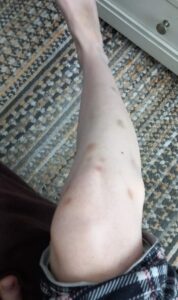 “Ash’s symptoms began around May 2024,” says Shelley, 48, Ash’s mum and a community complex care nurse and former intensive care nurse. “But there was a way of explaining them all. Fatigue was attributed to late nights. Shortness of breath in a hot shower was attributed to her mostly dormant lifestyle. Bleeding gums were from too roughly brushing teeth. Small bruises on her shins were put down to sitting on the floor using her laptop. Retrospectively, these were all big red flags because it was unusual for Ash, who was otherwise healthy.”
“Ash’s symptoms began around May 2024,” says Shelley, 48, Ash’s mum and a community complex care nurse and former intensive care nurse. “But there was a way of explaining them all. Fatigue was attributed to late nights. Shortness of breath in a hot shower was attributed to her mostly dormant lifestyle. Bleeding gums were from too roughly brushing teeth. Small bruises on her shins were put down to sitting on the floor using her laptop. Retrospectively, these were all big red flags because it was unusual for Ash, who was otherwise healthy.”
But when Ash later had a nosebleed that lasted four hours, a more intense period and an unusual bruise on her hip, Shelley put the pieces together. She knew Ash was experiencing leukaemia symptoms.
From her time caring for people in intensive care, Shelley knew it was important to book a blood test for Ash. By the time Ash had her blood test, she was visibly tired, very pale and had dark circles around her eyes.
Shelley was driving to work when she received the phone call she was dreading.
“I prayed he was going to tell me the sample had clotted, but he didn’t. He asked what my concerns were and I said ‘leukaemia’, he said I was correct. He said that a bed had already been booked for Ash at the hospital.”
Later that day, on 19th June 2024, it was confirmed that Ash had acute promyelocytic leukaemia (APML).
APML is a rare sub-type of acute myeloid leukaemia (AML) – just 160 people in the UK are diagnosed with it each year. At one time, it was the most fatal of all leukaemias as it progresses so quickly and dramatically, causing both clotting and bleeding. But thanks to research, APML now has one of the highest cure rates.
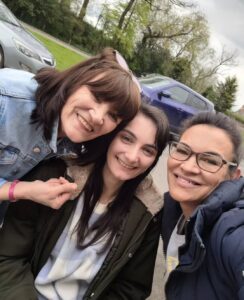
Ash 6 weeks before her diagnosis
Unlike other blood cancers, APML treatment isn’t chemotherapy, but drugs that target the specific mutation which causes APML – the PML-RARA fusion gene. There is now a cure rate of over 90%, provided it is caught early and diagnosed correctly.
“I drove home and screamed and cried and prayed the entire way. I called Ash and told her to get a bag ready for the hospital. She could see I’d been crying and said, ‘I’ve got cancer, haven’t I.’ We all sat on the floor in tears. Then we rushed to the hospital.
“On the way, she told me she didn’t want to know anything and trusted that I would make the right decisions. But the one thing she wanted to know was if she was going to die. My heart broke. I said, ‘not on my watch.’”
Ash said: “I don’t recall much about the moment of realisation that I had leukaemia, but the first thing that came to my mind was that I was going to die, which of course scared me. After that, all I wanted to know was if I had a chance to survive.”
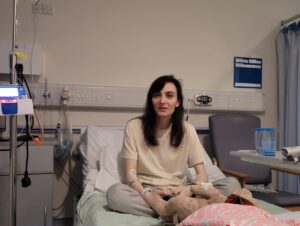
Ash on the day of her admission in hospital
Ash was immediately admitted to a private room and a registrar explained the seriousness of APML to Shelley – it was possible Ash would lose her life within two months.
Ash was given blood transfusions and the drug regime of all-trans retinoic acid (ATRA) and Cryoprecipitate, along with Idarubicin. She was then started on a longer-term regime of Arsenic trioxide alongside the ATRA. Ash also had daily ECGs, electrolyte replacement, and Acyclovir to prevent any viral infections, along with X-rays and scans to rule out any problems with clotting or bleeding. All of this was incredibly physically grueling for Ash, but also mentally challenging, given her social anxiety.
“For two months, Ash and I stayed in hospital,” said Shelley. “They gave me a pull-out bed and I slept beside her. Ash coped remarkably well. She got used to people coming in and out and talking to her. She visibly started to feel braver.”
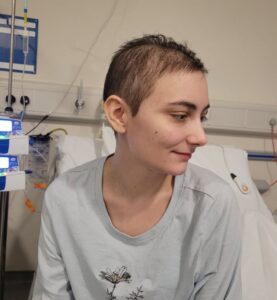 “I focused on the odds being in my favour and that I just needed to get through the next eight weeks,” added Ash. “After that, I didn’t think about it, I didn’t want to think about it. I would keep my mind busy with silly things like how bored I was or listen to music to distract my mind. It was more a case I knew I had to deal with strangers in order to survive, so I just did it. But not knowing the details made it easier and I trusted my mum to make the right decisions.”
“I focused on the odds being in my favour and that I just needed to get through the next eight weeks,” added Ash. “After that, I didn’t think about it, I didn’t want to think about it. I would keep my mind busy with silly things like how bored I was or listen to music to distract my mind. It was more a case I knew I had to deal with strangers in order to survive, so I just did it. But not knowing the details made it easier and I trusted my mum to make the right decisions.”
After those first few weeks, Ash returned home to continue treatment as an outpatient. Thankfully, her first bone marrow test after her first cycle of treatment showed she was in complete remission. She had two more rounds to consolidate her recovery and she is now no longer on any treatment.
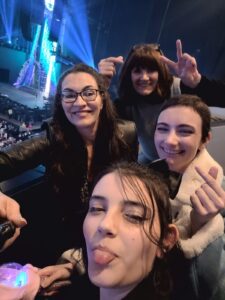
Ash earlier this year (2025) at a concert
“The whole experience has absolutely destroyed me but, strangely, it built Ash up. She has always had huge social anxiety, but this experience seems to have given her new confidence. She now walks to her grandmother’s, goes to the supermarket with her sister and has quiet conversations with the staff at the hospital.
“I cry about it all the time. I still can’t believe any of this has happened. Several times it has been mentioned that I have PTSD because my emotions are all over the place. I felt like I needed to talk about it all the time but when I did, I just cried.
“I have always been strong. Nothing scares me… but this absolutely terrified me. The only thing any of us hope for is that it doesn’t come back. I now donate blood, and her dad and his wife are running marathons to raise money and awareness for blood donation, leukaemia and the Teenage Cancer Trust.”
Related posts
10 August 2022
Leukaemia UK unveils an exciting new brand
Leukaemia UK has today revealed a bold new look and feel that embodies the charity’s ambitious new strategy and our desire to be a greater force for change. Bringing together…
3 February 2022
New analysis reveals the stark disparities in cancer rates between ethnic groups
The Cancer Research UK study demonstrates the importance of understanding the differences and inequalities in cancer and to highlight where improvements in survival, treatment and care can be made.
11 August 2021
Dr Samanta Mariani recognised for her innovative research through Leukaemia UK John Goldman Fellowship and Olive Boles Innovation Award
We are delighted to announce the Leukaemia UK John Goldman Fellowship and Olive Boles Innovation Award has been awarded to Dr Samanta Mariani, in recognition of her innovative research that could contribute significantly to our understanding of leukaemia and other blood cancers.
28 November 2022
Leukaemia UK John Goldman Fellow awarded Professorship
Talented blood cancer researcher, Vignir Helgason, was awarded a Leukaemia UK John Goldman Fellowship in 2015, for his research into chronic myeloid leukaemia (CML). Since then, his research career has…